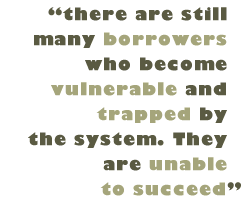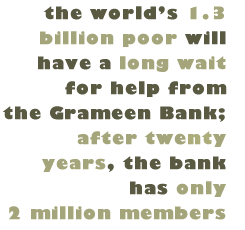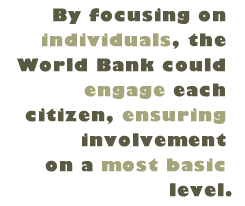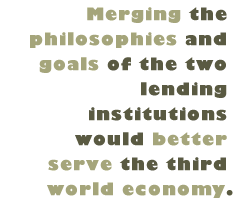Home-Art
329-GS 330-Lit 342-Hum
375-Com 385-GS 410-GS 450,
Research-GS 450, Integration
|
|
|
Written by Jessica Albon |
|
| Note: You may wish to visit
the glossary for this paper
|
The first of the two organizations to be studied, the World Bank, seeks to encourage economic development by pursuing unrestrained capitalism and making significant loans to member countries. The second of these organizations, the Grameen Bank makes micro-credit loans to individuals. The World Bank believes a country cannot prosper without physical infrastructure and the size of the loans made reflect this. On the other hand, the Grameen Bank believes an individual cannot prosper without financial support, empowerment, and education. The World Bank and the Grameen Bank could scarcely be more opposite in their approaches and thus seem like good institutions to compare for a well-rounded observation of efforts to eradicate poverty. To compare these organizations and offer a solution, this paper will take the following structure. First, each of the organizations will be introduced separately with respective histories presented, missions discussed, and the opposition considered. Second, the organizations will be compared so that the reader may better see the similarities and differences. Third, the problem of third world poverty and the approaches of these institutions will be analyzed. Finally, after comparing these institutions, considering their opposition, and examining their records in the third world, a possible solution to the problem of third world poverty will be presented.
|
|
|

Today, the World Bank has five agencies (the IBRD, IDA, IFC, MIGA, ICSID) that offer loans to the members of the World Bank. By making these loans, they attempt to: "fight poverty with passion and professionalism for lasting results[;] [and,]…help people help themselves and their environment" (The World Bank). They believe this mission is best accomplished by loaning developing countries large sums of money for governmental projects that are designed to provide resources and build capacity (such as power plants). They also believe that by encouraging the third world to rely on first world businesses (as is often required for these large projects because third world industries typically lack the training and technology necessary) will strengthen worldwide bonds between the first and third world. World Bank loans come with hefty terms in most cases however with typical terms including structural adjustment programs (SAPs) that limit governmental spending and eliminate barriers to trade such as tariffs and taxes (CorpWatch). The World Bank's belief that the way the third world should develop is through trade and foreign investment is based on modernization theory. Philip Porter and Eric Sheppard explain modernization theory in their text, A World of Difference, a book that examines links between geography and current economic inequalities. They write that modernization theory holds that "all nations occupy positions on a spectrum running from 'traditional' societies at one extreme to 'modern' societies at the other, and that nations may move from the former to the latter group by adopting the characteristics of 'modern' societies" (Porter and Sheppard, 82). As proponents of modernization theory, the World Bank seeks to help the third world develop along a proscribed path similar to that which the first world traveled. |
|
|
By looking at the voting structure of the World Bank, it seems that there is grounds for suspicion. It would seem reasonable that in an organization that tries to strengthen the economies of the third world, each member nation would have an equal share of the vote. This would allow for all members to have an equal say in the use of money regardless of that member's contribution. In the World Bank, however, members cast votes according to the size of their monetary contribution to the bank. As a result, the G-7 (Britain, Canada, France, Germany, Italy, Japan, and the United States) holds 45% of the vote (CorpWatch). Beyond the obvious inequality of 7 countries having 45% of the vote while 176 share the remaining 55%, critics contend that this division of votes may result in World Bank-supported projects that will result in increased revenue for first world countries and increased degradation of the third world (Fifty Years is Enough). They suggest the World Bank's large-scale projects often require expertise, supplies, and machinery that the third world cannot find domestically and must instead purchase from private companies in the first world. Another reason some criticize the World Bank is that the board members of the World Bank are from the first world and many question whether they can truly understand the cultures and needs of the third world. Criticisms abound that the World Bank simply does not understand poverty. In fact, their own officials acknowledge that $450 billion dollars in third world aid has left little "to show for the money except some grandiose infrastructure projects" (Skousen). Even the UN criticizes the World Bank's first world viewpoint. In the report, "Strategy for the Cross-Cutting Theme 'Eradication of Poverty, Especially Extreme Poverty,'" UNESCO writes,
|
|
|

Today, the Grameen Bank continues to make such small loans to individuals who will use that money to create a better life for themselves and their families. By offering micro-credit loans for businesses and homes to the "poorest of the poor," the Grameen Bank has become something of a legacy in the micro-credit world. They require no collateral from their borrowers, but offer a significant improvement over the common lenders (often referred to as "money sharks") who generally charge interest rates so high that borrowers become even deeper in debt. Interest rates are higher than typical bank rates, however, as the bank maintains self-sufficiency and must charge enough interest to keep it solvent. The Grameen Bank makes loans primarily to women (94% of borrowers are women) as they have found that the money made by women tends to have a more direct effect on the health and quality of life of the entire family, whereas men are more likely to spend their money on personal luxuries (Grameen Bank Introduction). Also, in keeping with their mission to serve the poorest of the poor, the Grameen Bank has recognized that women are more often marginalized than men and are less likely to have access to traditional credit (Ibid.). In order to serve women without collateral, the Grameen Bank requires that prospective borrowers organize into groups of five. Of these five group members, only two are eligible to receive loans at a time (Grameen Bank Introduction). After one year, if both members have repaid their loans (which typically last fifty weeks), other group members become eligible for loans. If a loan is ever not repaid, the remaining members become ineligible. This group pressure ensures that loans are repaid on time. In fact, the Grameen Bank is able to boast of a 98% repayment rate as a result of these practices. |
|
|

Indeed, it seems worthwhile to consider whether the empowerment of individuals is enough. The World Bank believes that infrastructure must be provided in order for an economy to prosper while the Grameen Bank seems to take an opposite approach. Surely lack of infrastructure holds back the borrowers of the Grameen Bank in many ways. While first world business owners would be able to take advantage of easy access to well-maintained roads, third world borrowers must face difficulty in transporting their products to markets. They also likely pay more for supplies as they are more expensive to deliver. Though such concerns may be entirely first worldly and may not affect the Grameen Bank's borrowers at all, it does seem relevant to consider the importance of infrastructure in economics. Critics also contend that the Grameen Bank requires a certain cultural environment. In Bangladesh, women have great concern about their personal reputations and worry that people will gossip if they do not repay their loans. This seems to indicate that such a structure might not work in cultures that are more individualistic (concerned more with self than community) instead of tending towards the collectivistic (concerned more with community than self). In other areas of the world, including the United States, where group opinions are not such a concern, Grameen replications have been unsuccessful. Additionally, the Grameen Bank requires that the government support micro-enterprises within the informal sector. As informal economic activity is generally discouraged by more "modern" governments, Grameen reproductions may be unlikely in such areas (Buntin). Another criticism of the Grameen Bank is that though the loans are almost always made to women, the women may not have control over these loans. According to Aminur Rahman, a University of Manitoba doctoral student who visited Bangladesh to study the Grameen Bank in 1994, "'there are still many borrowers who become vulnerable and trapped by the system. They are unable to succeed'" (qtd. in Pepall). He spoke with 120 female borrowers and found that 108 were told to pursue a Grameen Bank loan by men (generally a husband or brother) and that 72 of those loans were then used by men. Economic journalist Gina Neff also reports that women retained control over the businesses for which a loan was taken out only 37% of the time (Pepall and Neff). Rahman believes that while the Grameen Bank has an appropriate philosophy, in practice it has not been enough to empower women. In fact, in her article, "Bangladeshi Women and the Grameen Bank," Jennifer Pepall reports that men are more likely to abuse their wives, sisters, and daughters following loans from the Grameen Bank. This increase in violence, she says, often comes as a result of the politics surrounding the loans, because women may refuse to take out additional loans, or because a woman may refuse to use the money in the way that her husband, brother or father expects. Thus, though the Grameen Bank is largely lauded as an institution of empowerment, it may not have delivered on that promise just yet. |
|
|

It seems especially important to Yusuf that the ideas of the poor be given weight, that their views and opinions be validated. He works to empower them, not to change them or improve them. On the other hand, the World Bank seems to see itself as a kind of parent, ready to guide the third world to development. Though the World Bank does have the experience of leading first world economists shaping policy, it seems one-sided to believe that they can show the third world the only path to development. |
|
|
One of the
major differences between the World Bank and the Grameen Bank, aside from approach,
involves money. In 1994, the World Bank's budget measured US$17 billion annually (Fifty
Years is Enough). On the other hand, the Grameen Bank has managed to raise only a
little over three billion dollars in the twenty years they've been giving loans
(Grameen Bank Introduction). This three billion dollars that the Grameen Bank has
raised has been used for loans, growth, and all the expenses that accompany the bank
including staff and facilities. However, according to many accounts, the Grameen Bank
has made a much more substantial difference. While the Grameen Bank has helped 54% of
their borrowers rise above the poverty line, the World Bank has acknowledged that the
world added 200 million impoverished people to the population between 1993 and 1998
(Grameen Bank Introduction & The Whirled Bank).
Because of their comparably small budget, the Grameen Bank does not have the resources to change the world as rapidly as the World Bank might be able to. Additionally, by insisting that the bank be self-sufficient, the Grameen Bank limits its annual growth. While this is a reasonable way to approach growth, it seems that the world's 1.3 billion impoverished citizens will have to wait a very long time to be helped by the Grameen Bank, as currently there are only a little more than 2 million members (Grameen Bank Official Website). |

As has already been established, the World Bank has an enormous annual budget. It also is not required to be self-sufficient as the world supports it with financial contributions each year. Though the Grameen Bank's goal to be self-sufficient seems admirable, it also seems that eradicating poverty is such a demanding goal that it might be too much of a challenge to do both. The World Bank has the power and financial support of the world behind it. In order for the third world to readily find financial freedom, this power needs to be mobilized to aid the third world. By supporting localized programs that eradicated poverty on an individual level, it seems likely the World Bank would be able to effect change much more rapidly than the Grameen Bank is currently able on its own. In considering this idea, however, it is important to recognize that a key reason for the Grameen Bank's success is that Yusuf is from Bangladesh and constructed a program that would work with the area's unique culture. Each area is different and these differences must be considered by people who are intimately involved with these areas. For these reasons, this paper proposes that the World Bank establish training centers in each of the third world countries to solicit feedback from individuals within these countries as to what programs they would find most beneficial. Next, a nation's leading economic figures might be called together to offer their opinions on each of these programs. The World Bank should restrict its role to only offer the financial support and perhaps also information resources to the third world that would help each nation develop its own plan of action. |
|
|
|
By addressing
the people of a nation and not the government of a nation, the World Bank would be much
more likely to see results. By starting such programs on an individual level, the
citizens of each nation would feel involved with the process and would have a more
lasting commitment to that process. By discovering what the individuals of a nation
want for their nation's future, the World Bank could take on the approach of the
Grameen Bank-they would no longer tell anyone how to spend the money, but would rather
provide support when needed.
Also necessary is a restructuring of the voting process of the World Bank. While it could be argued that it is primarily the first world's money and therefore they should decide how it is spent, this may not be the wisest way to use this money. The first world cannot possibly know what programs will work best in the third world and instead should follow Yusuf's example. In order to allow the third world this improved role, each country's vote should be equal and the board of directors of the World Bank should represent each country equally. The first world should realize that by empowering the third world to take control of the future, their money will be more secure and the third world will be more likely to be able to better participate in the world economy. |
|
|
By allowing the third world to take a more active role in their financial future, the World Bank would ensure that each country would be enabled to make its own decisions. Currently, the World Bank only loans money to countries and NGOs that agree to certain terms. The Grameen Bank, on the other hand, allows the poor to take such an active role in determining their own future and it seems likely that this allowance encourages the poor to accomplish the impossible. As Yusef has said himself, he cares only that borrowers repay their loans, not what they do with the money. Thus, the Grameen Bank encourages third world borrowers to make their own choices and determine their own course while the World Bank sees the first world's path as the only way to grow. The World Bank's philosophy is to build an infrastructure to support a growing economy, while the Grameen Bank's goal is to strengthen the economy from the individual upward. |
|
|
If the
philosophies and goals of the two lending institutions could be merged and refined, the
third world economy would be far better served. By encouraging the third world to
follow individual paths to development, as does the Grameen Bank, instead of the
dictates of the World Bank, sustainable development can be achieved. The World Bank has
the resources of the entire world at its command. These resources should be used to
make a difference in the world, to empower the poor. Currently, the World Bank has
little to show for its huge investments of money and time, however, by becoming more
sensitive to the local cultures of the countries they give loans to, they would likely
see much improvement. Likewise, the Grameen Bank, for all its individual successes, has
made little progress in eliminating world poverty. This is mainly due to their limited
resources. Together, the two financial institutions could present a formidable opponent
to third world poverty.
See Works Cited |
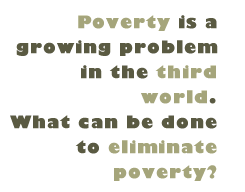
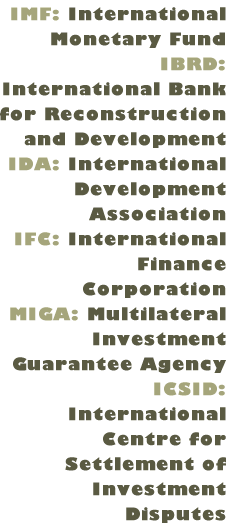
 reated
by the Bretton Woods conference of 1944, the World Bank (initially the IBRD), began
with 44 member nations (The World Bank). Member nations believed "global
development requires the full convertibility of currencies in addition to free
trade" and thus established both the World Bank and the International Monetary
Fund (IMF) to make loans to member nations and establish a currency standard
(determining also that the US dollar, linked to a gold standard, would be the principal
currency) (Porter & Sheppard, 368-69).
reated
by the Bretton Woods conference of 1944, the World Bank (initially the IBRD), began
with 44 member nations (The World Bank). Member nations believed "global
development requires the full convertibility of currencies in addition to free
trade" and thus established both the World Bank and the International Monetary
Fund (IMF) to make loans to member nations and establish a currency standard
(determining also that the US dollar, linked to a gold standard, would be the principal
currency) (Porter & Sheppard, 368-69).
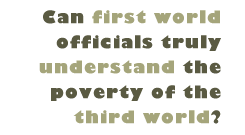
 any
believe, along with the World Bank, that modernization is the only way for the third
world to escape poverty. Others, however, including Fifty Years is Enough (a grassroots
organization that researches the impacts of the World Bank) believe that modernization
means homogenization of the world's cultures and that such a limiting of diversity is
undesirable. Fifty Years is Enough actually goes further, arguing that the World Bank's
practices are intended to strengthen the economies of the first world, not the third.
any
believe, along with the World Bank, that modernization is the only way for the third
world to escape poverty. Others, however, including Fifty Years is Enough (a grassroots
organization that researches the impacts of the World Bank) believe that modernization
means homogenization of the world's cultures and that such a limiting of diversity is
undesirable. Fifty Years is Enough actually goes further, arguing that the World Bank's
practices are intended to strengthen the economies of the first world, not the third.
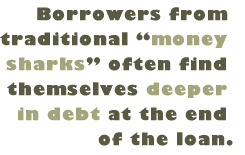
 he
Grameen Bank's origins are entirely different from the origins of the World Bank. The
Grameen Bank was established by and individual instead of a mass of people. Thus, it
seems less steeped in bureaucracy. Indeed, when Grameen Bank borrowers protested
payment policies, those policies were immediately reconsidered (Pepall). The World
Bank's policies are more difficult to change as they must pass through several layers
of control. Additionally, the Grameen Bank's founder, Muhammad Yusuf, is a Bangladeshi
himself. Thus he has a tie to the people of Bangladesh and is seen as less intrusive
than an organization perpetuated by the first world. The Grameen Bank is more organic
to the problems of the third world, having arisen from Yusuf's own observations of the
culture and economic situation that surrounded him in Bangladesh. In 1983, Yusuf met
Sophia Katoon, a Bangladeshi furniture maker who was deeply in debt to money sharks
(Porter & Sheppard, 526). He gave her several dollars as a loan; within just a few
months, her income increased seven fold, and she repaid the loan easily (Grameen Bank
Introduction).
he
Grameen Bank's origins are entirely different from the origins of the World Bank. The
Grameen Bank was established by and individual instead of a mass of people. Thus, it
seems less steeped in bureaucracy. Indeed, when Grameen Bank borrowers protested
payment policies, those policies were immediately reconsidered (Pepall). The World
Bank's policies are more difficult to change as they must pass through several layers
of control. Additionally, the Grameen Bank's founder, Muhammad Yusuf, is a Bangladeshi
himself. Thus he has a tie to the people of Bangladesh and is seen as less intrusive
than an organization perpetuated by the first world. The Grameen Bank is more organic
to the problems of the third world, having arisen from Yusuf's own observations of the
culture and economic situation that surrounded him in Bangladesh. In 1983, Yusuf met
Sophia Katoon, a Bangladeshi furniture maker who was deeply in debt to money sharks
(Porter & Sheppard, 526). He gave her several dollars as a loan; within just a few
months, her income increased seven fold, and she repaid the loan easily (Grameen Bank
Introduction).
